Every player at every level dreams of being a match-winner. Unfortunately cricket isn’t always rainbows and unicorns.
Sometimes someone will play outstandingly yet his team will be defeated. In the subsequent media conference he’ll state that ‘I’d rather fail and see my side win, than do well in a loss’. It’s a cliché, but generally true. Except maybe for Geoff Boycott.
This series will rank the best performances by an Australian in a lost Test. Part 1 will deal with bowlers, and Part 2 with batsmen.
To shortlist the best lone-hand lost-cause performances, I applied three simple criteria: that the side lost, that the player took at least half of his opponent’s wickets, and that none of his teammates also played a significant role with the ball.
This is my top ten. Without these performances some narrow losses would have been large ones, and some large ones humiliating. And with more support, many of these defeats would have been victories.
1. Merv Hughes, Australia versus West Indies, WACA, 1988-89
Hughes led the Australian pace attack during the late 1980s and early 1990s. In 53 matches he took 212 wickets at 28.38, including five wickets in an innings on seven occasions.
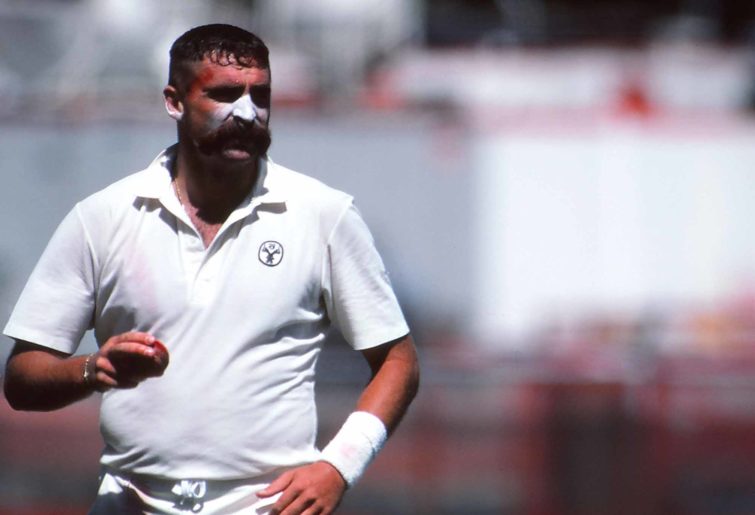
(Photo by Getty Images)
At the time of this game the West Indies was the dominant Test side. One week earlier at the Gabba it had comfortably defeated Australia in the series’ first match. During the preceding winter it had won 4-0 in England.
The visitors batted first and scored 449. Hughes bowled 36.1 overs, the most of any bowler, to take 5-130. Geoff Lawson supported him well with 3-97.
Australia fought hard in reply, before declaring its innings at 8-395. The closure was forced by Lawson suffering a fractured jaw at the hands of Curtly Ambrose. Lawson took no further part in the match.
The West Indies batted again and closed its second innings at 9-349. With his side a bowler short, Hughes assumed the roles of both strike and stock bowler. He took the first six wickets to fall, and laboured for 37 overs to take 8-87. The home side was set 404 for victory, and scored 234 to lose by 169 runs.
For the match, Hughes took 13-217 from 73.1 overs. Those wickets included a hat trick spread across two days, two innings and three separate overs. The unique feat was not immediately realised.
His teammates took 6-565 from 148 overs. Tony Dodemaide’s share was 1-180 from 41 overs. Tim May and Steve Waugh took 2-108 and 0-160 respectively.
Hughes later found himself without a new-ball partner for both innings at Lord’s in 1993, after Craig McDermott suffered a twisted bowel. Fortunately in that game Shane Warne and Tim May supported Hughes well, and their side won that match by an innings.
Hughes’ performance has earned him first place on this list. He took the most wickets by any Australian in a loss. He bowled 33 per cent of his side’s overs, while his side was missing a bowler. His own bowling average for the match was one fifth of that of his teammates. And he did so against one of the strongest teams in history.
2. Mitchell Johnson, Australia versus South Africa, WACA, 2008-09
Left-armer Johnson is one of the most intimidating bowlers to have represented Australia. In 73 matches he took 313 wickets at 28.40, including five wickets in an innings on 12 occasions.
In this game Australia batted first and totalled 375, with Johnson contributing 18 to a strong recovery from 3-15 and then 5-166. The visitors were restricted to 281 in reply, due to Johnson’s 8-61 from 24 overs including one spell of five wickets for two runs. When the home side batted again it scored 319 of which Johnson’s share was a useful 21.
Centuries to AB de Villiers and captain Graeme Smith then enabled South Africa to achieve its 413-run target with six wickets to spare. Johnson delivered more overs in the innings than any other bowler, and removed three of the four batsmen dismissed for a return of 3-98 from 34.2 overs.
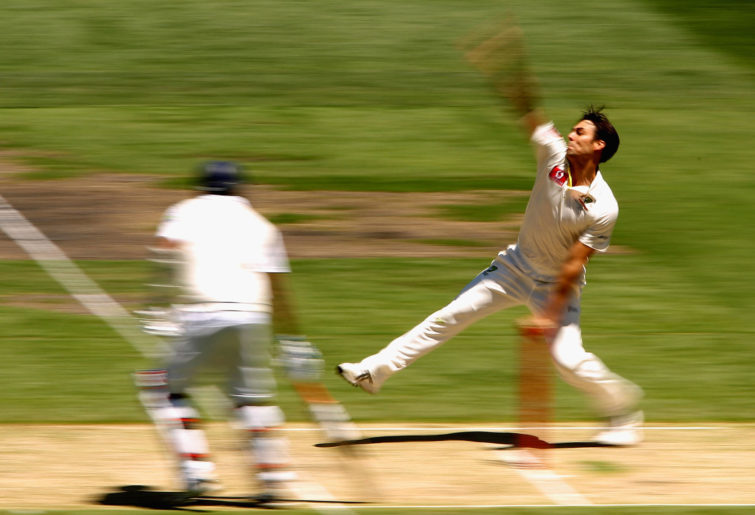
(Photo by Robert Prezioso/Getty Images)
For the match, his analysis was 11-159 from 58.2 overs. His teammates took 3-509 from 150.5 overs. Brett Lee took 1-132 and Peter Siddle claimed 1-128. Jason Krejza took 1-204 and never represented Australia again.
South Africa’s successful run chase is the second highest of all time. De Villiers claimed the man of the match award for innings of 63 and 106 not out, as well as four catches including ones that removed Ricky Ponting and Mike Hussey for ducks.
Johnson’s performance has earned him second place on this list. He took 79 per cent of his side’s wickets, and no teammate took more than one wicket. His own bowling average for the match was one 12th that of his fellow bowlers.
3. Alan Davidson, India versus Australia, Kanpur, 1959-60
‘The Claw’ is one of the finest fast bowlers, all-rounders and fieldsmen of all time. In 44 matches the left-hander took 186 wickets at 20.53 including five wickets in an innings on 14 occasions.
At the time India had never defeated Australia, and had lost 11 of its 14 previous games. The match was Australia’s fifth in a gruelling eight-Test tour to India and Pakistan, that would never be scheduled nowadays. Three players and the team’s doctor returned home early due to illness, including two with hepatitis and one with food poisoning.
In this game the home team batted first and was restricted to 152. Davidson delivered 20.1 overs for 5-31. Australia responded by reaching 1-128 before off-spinning medium-pacer Jasubhai Patel took 9-69 to limit it to 219, of which Davidson contributed a handy 41 runs from number six.
When India batted again it scored 291. Davidson again starred with the ball, delivering 57.3 overs and taking 7-93. Wikipedia states that during the match’s third day, he bowled 40 overs in 38-degree heat.
Following his heroics, Australia could score only 105 in its second innings and lost the match by 119 runs. While he contributed just eight runs to that total, only three of his teammates scored more.
For the match, Davidson bowled 77.4 overs in taking 12-124. His teammates’ collective figures were 8-306 from 137.1 overs, with Richie Benaud taking five of those wickets. Only Colin McDonald and Neil Harvey outscored him with the bat.
Davidson’s performance has earned him third place on this list. It took place away from home in extreme conditions. He bowled the most deliveries of any bowler in this list. His own bowling average for the match was almost one quarter that of his fellow bowlers. And in addition, he made a significant score with the bat.
4. Shane Warne, Australia versus South Africa, SCG, 1993-94
Warne’s career speaks for itself. He’s arguably the greatest ever wrist-spin bowler and took more wickets than anyone except Muttiah Muralitharan.
South Africa was playing its first Test series in Australia for three decades, two years after returning to international cricket. Australia had retained the Ashes away 4-1, and then won 2-0 at home against New Zealand.
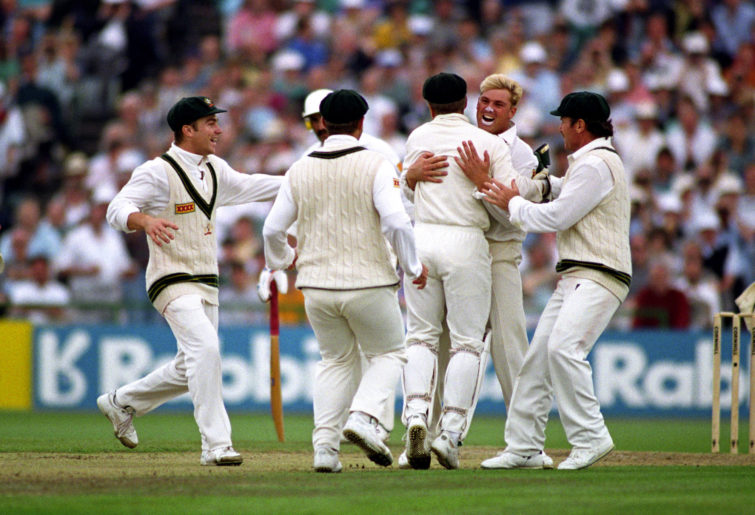
(Photo by Rui Vieira/EMPICS via Getty Images)
In this game the visitors batted first and struggled to total 169. Warne bowled 27 overs to take 7-56. Australia replied with 292 for a 123-run first-innings lead.
When South Africa batted again it recovered from 5-110 to reach 239. Warne delivered another 42 overs for a yield of 5-72. Despite the visitors’ recovery their overall lead was only 116. They successfully defended it, as the home side took 56.3 overs and 264 minutes to score 111 runs.
For the match Warne took 12-128 from 69 overs. His teammates collectively took 8-261 from 114.1 overs, with Craig McDermott claiming six of those wickets.
McDermott was almost the hero with an undefeated 29 from number ten. In Adelaide during the previous summer he had been the last man dismissed in a loss to the West Indies by one run. Hopefully his nightmares are beginning to fade.
Eleven years later at Edgbaston, Warne found himself in an almost identical position. Despite taking 4-116 and 6-46, and scoring a second-innings 42 with the bat, Australia lost that thrilling match by just two runs.
Warne’s performance has earned him fourth place on this list. It remains the best match return of his entire career. He bowled 38 per cent of his side’s overs. Only Merv Hughes has taken more wickets by an Australian in a loss.
5. Geoff Lawson, Australia versus West Indies, Adelaide Oval, 1984-85
‘Henry’ Lawson was a key member of Australia’s fast-bowling attacks of the 1980s. In 46 matches he took 180 wickets at 30.56, including five wickets in an innings on 11 occasions.
A dominant West Indies had beaten England away 5-0 and Australia at home 3-0, then won this series’ first two matches. Allan Border was Australia’s new captain, following Kim Hughes’ tearful resignation.
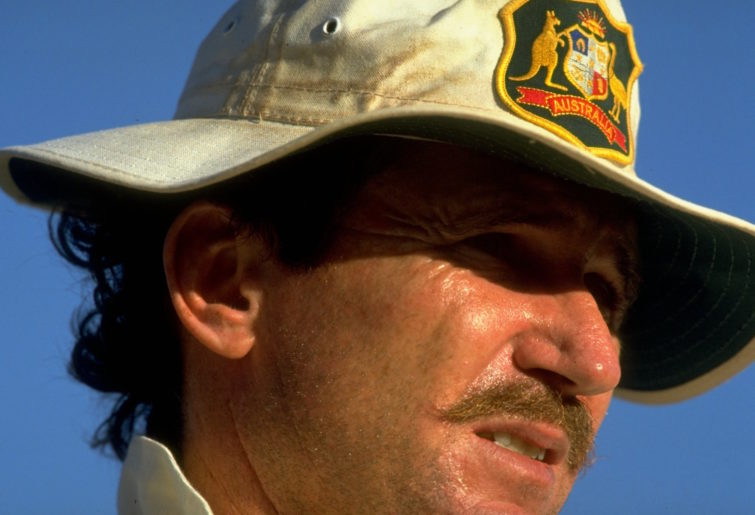
(Credit: Ben Radford/Allsport via Getty Images)
In this game the visitors batted first and scored 356. Lawson delivered 40 overs, far more than any other bowler, and took 8-112. The only wickets that he did not take were the first and last ones.
Australia replied with just 284. Lawson commenced batting at 6-145, and contributed 49 to a 109-run partnership with Kepler Wessels. Lawson’s innings was surpassed only by that of Wessels.
The West Indies batted again and declared at 7-292. Lawson again bore the brunt of the bowling workload, with 3-69 from 24 overs. The home side chased 365 for victory, and scored 173 to lose by 191 runs.
For the match, Lawson delivered 64 overs for a return of 11-181. Five teammates bowled a collective total of 137.3 overs, for a yield of 6-456. Rodney Hogg took four of those wickets.
Lawson’s performance has earned him fifth place on this list. He produced it against one of the strongest teams of all time. All but six of the wickets taken fell to him. His own bowling average was almost one fifth that of his teammates. He also made an important contribution with the bat.
6. Hugh Trumble, England versus Australia, the Oval, 1902
Trumble was Australia’s first great spin bowler. In 32 matches he took 141 wickets at an average of 21.78. Those figures included two hat tricks, and five wickets in an innings on nine occasions.
This game was arguably one of the most exciting of all time. It would conclude one of the most famous series of all time.
Australia batted first and scored 324. Trumble contributed an undefeated 64 from number nine. Following heavy overnight rain the home side could only reply with 183. Trumble bowled unchanged for its entire innings to take 8-65 from 31 overs.
The visitors batted again with a 141-run first-innings lead but could add only a further 121, with Trumble scoring seven not out. However their overall lead of 262 appeared insurmountable.
Chasing 263, England slipped to 5-48 before Gilbert Jessop’s whirlwind 80-ball 104 inspired a recovery to 7-187 and then 9-248. Its final pair George Hirst and Wilfred Rhodes added the remaining 15 runs for Test cricket’s first one-wicket victory. Trumble again bowled unchanged, to take 4-108 from 33.5 overs.
For the match, Trumble outscored every teammate with 71 runs without being dismissed, and bowled all 64.5 overs from one end to take 12-173. His fellow bowlers had collective figures of 7-247 from 63 overs. Jack Saunders claimed six of those wickets.
In 1896, Trumble had been similarly unfortunate at the very same ground. During that game he delivered 65 of the 65.3 overs bowled from one end, to take 6-59 and 6-30. England scored just 145 and 84. However Australia could total only 119 and 44 to comfortably lose the match by 66 runs.

(Photo by Ryan Pierse/Getty Images)
Trumble’s performance has earned him sixth place on this list. It was made against an extremely strong side playing at home. He bowled unchanged in each innings. Only Merv Hughes has taken more wickets in an Australian loss. He also top-scored for his team.
7. Ray Bright, Pakistan versus Australia, Karachi, 1979-80
‘Candles’ Bright was a steady left-arm finger spinner who played before and after two seasons of World Series Cricket. In 25 matches he took 53 wickets at 41.13, with a modest strike rate of one wicket per 104 balls.
In this game Australia batted first and registered 225, to which the home side replied with 292. Bright was his team’s stand-out bowler with 7-87 from 46.5 overs. Greg Chappell took all three remaining wickets.
When the visitors batted again they reached only 140. Pakistan achieved its modest 74-run victory target for the loss of just three wickets. Bright took all of them, for figures of 3-24 from 11 overs.
For the match, Bright took 10-111 from 57.5 overs. In contrast the other specialist bowlers Dennis Lillee, Geoff Dymock and debutant Graeme Beard returned collective figures of 0-165 from 64.1 overs. Chappell’s wickets were the only other ones claimed.
He had a far more satisfying experience on the sub-continent in 1986-87. His figures of 2-88 and 5-94 in Chennai assisted Australia to achieve a historic tie.
Bright’s performance has earned him seventh place on this list. No other specialist bowler took a wicket for Australia in the match. His own bowling average for the game was nearly one eighth of that of his teammates. He also bowled 40 per cent of his side’s overs.
8. Geoff Dymock, India versus Australia, Kanpur, 1979-80
Dymock was a hard-working left-arm fast-medium bowler. In 21 matches he took 78 wickets at 27.12, including five wickets in an innings on five occasions.
This game was the third of a six-Test series, the last before World Series Cricket’s players returned. Match scores were generally high, and four of the games were drawn.
India batted first and totalled 271 after being 1-201. Dymock delivered more overs than any other bowler, to take 5-99 from 35 overs. The visitors replied with 304, for a valuable 33-run lead.

(Photo by Daniel Pockett – CA/Cricket Australia via Getty Images )
When the home side batted again it reached 311. Dymock again led the bowling attack, with 7-67 from 28.4 overs. Unfortunately Australia fell well short of its 279-run victory target, being dismissed for 125 to suffer a 153-run loss.
For the match, Dymock took 12-166 from 63.4 overs. Across two innings he dismissed every one of India’s 11 players. His fellow bowlers took 8-349 from 139 overs, with Rodney Hogg claiming four of those wickets.
Dymock’s performance has earned him eighth place on this list. It was reminiscent of the one at the same ground by fellow left-armer Alan Davidson, exactly 20 years previously.
9. Fred Spofforth, Australia versus England, SCG, 1882-83
‘The Demon’ was Australia’s first great bowler. He played in 18 of its first 25 matches, taking 94 wickets at an average of 18.41. Those figures included Test cricket’s first hat trick, and five wickets in an innings on seven occasions.
The Ashes had been conceived just five months earlier, after Australia defeated England by seven runs at the Oval. Spofforth was the match-winner on that occasion with hauls of 7-46 and 7-44. One hundred and thirty-nine years later the only Australian to have claimed better match figures is Bob Massie, at Lord’s in 1972.
Now, the trophy would be awarded for the first time. The series was level at one victory apiece, and this last match would be timeless. Playing conditions included four-ball overs, one ball per innings, a separate pitch for each team, and a compulsory follow-on for any team 80 runs behind.
In the game England batted first and amassed 247. Spofforth delivered 51 overs for 4-73. The home side replied with 218.
When the visitors batted again on their by now rain-affected pitch, runs were harder to come by. They scored just 123. Spofforth was again Australia’s star. He bowled unchanged for 41.1 overs, including two in succession as was legal at the time, and took a further 7-44.
Spofforth’s match figures were 11-117 from 92.1 four-ball overs. His teammates collectively took just 8-234 from 131 overs. The next best performer was round-armer Tom Horan with three wickets.
Unfortunately Spofforth’s efforts were in vain. Australia could score only 83 and the visitors secured a 69-run victory, and so claimed the very first Ashes series.
Spofforth’s performance has earned him ninth place on this list. It was the first great bowling performance by an Australian in a loss. He also bowled 41 per cent of his side’s overs.
10. Nathan Lyon, India versus Australia, Delhi, 2012-13
Lyon is Australia’s most prolific finger spinner. In 100 matches to date his off-breaks have claimed 399 wickets at 32.12, including five wickets in an innings on 18 occasions.
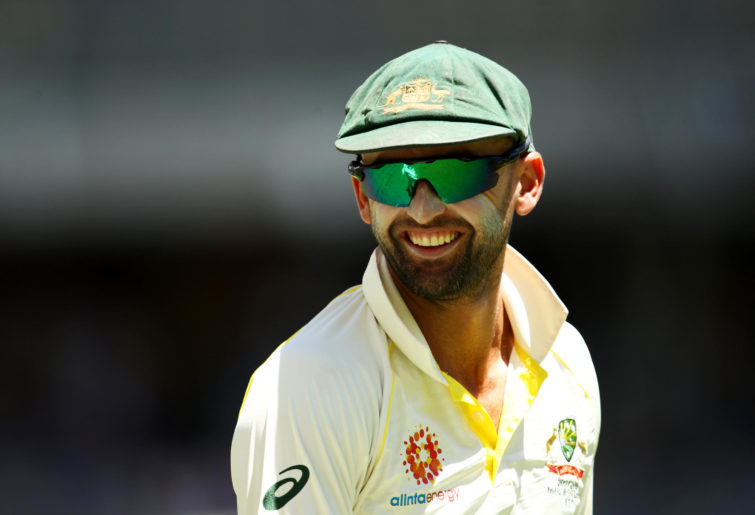
(Cameron Spencer/Getty Images)
This was the final Test of an eventful series that India was leading 3-0. Shane Watson captained the Australian side on his return from suspension for failing to complete homework, and in the absence of an injured Michael Clarke.
In the game Australia batted first and after collapsing from 1-71 to 7-136, recovered to 262 all out. India replied strongly with a 108-run opening partnership before being held to 272.
The visitors’ competitive position was almost entirely due to Lyon, who took 7-94 from 23.2 overs. Unfortunately they were then dismissed for 164 in their second innings.
The home team completed a series clean sweep by reaching its 155-run target for the loss of four wickets. Lyon opened the bowling to claim 2-71 from 15.2 overs. After opening the batting, Glenn Maxwell took the new ball as well.
For the match, Lyon took 9-165 from 38.4 overs. His fellow bowlers took 5-225 from 63 overs. Maxwell was the most successful of them, with three wickets.
Surprisingly, Lyon did not retain his place for Australia’s next match a few months later at Trent Bridge. Ashton Agar was preferred instead and debuted at the age of 19 years.
Lyon’s performance has earned him tenth place on this list. He claimed 64 per cent of his side’s wickets. The team’s other specialist bowlers claimed only two wickets in total.




































































































